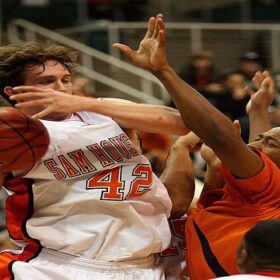In today’s basketball, players are getting stronger and smarter than ever. As the game evolves, many unique strategic plays are executed by different teams. There are many strategic plays that different coaches use to win the ball game, you will be surprised if I tell you that one of the commonly used strategic plays is intentionally fouling.
Committing a foul is one of the reasons why coaches are getting angry, especially if you are in foul trouble. But sometimes coaches are telling their players to commit a foul as a strategic play, this strategic play takes place in some situations. But what are their reasons? Why do players commit an intentional foul? Why intentional foul became a strategic play in today’s basketball?
Today I am going to answer all the questions above. This article will tackle different reasons on why basketball players commit intentional fouls. Let’s go!
What Is Intentional Foul In Basketball?
An intentional foul is a foul that is intentionally committed by a defensive player for a purpose. These intentional fouls are purposely given for a purpose, and intentional foul is one of the strategic moves of a coach to win the ball game.
Why Do Basketball Players Commit Intentional Foul?
There are different reasons why basketball players commit an intentional foul. These are the main reasons why:
To Prevent Bad Free Throw Shooters To Score
Centers are one of the targets of this strategic play. The centers are not good at sinking in a free throw, but it is easy for them to sink in close shots. Players that are smart enough to prevent centers from easily scoring a basket that is why they intentionally foul them, they believe that a free throw is better than a lay-up.
Players like Shaq experienced this kind of play from his opposing teams. Shaq is a good center and a good scorer, almost every NBA player is afraid when he steps into the paint. When Shaq entered the paint, players guarding him started to intentionally foul him to get him into the free-throw line. Sadly, Shaq is not a good free-throw shooter, that is why players believe it is better to intentionally foul him and hope he missed his free throws.
Before coaches and players execute this strategic play on their opposing players, they check first their free throw percentage. If the player’s free throw percentage is bad, then it is better to intentionally foul him/her.
To Prevent Fast Break Scores
Fast breaks are one of the easiest strategic plays to execute to get an easy basket. Players intentionally foul the opposing team if they sense that the opposing team is starting a fast break. But players just don’t intentionally foul a player even when they know the opposing team will start a fast break because they are also afraid to commit a clear path foul, clear path foul has bigger consequences when committed.
The worst offense, careless pass, and bad communication are the cause of getting turnovers, and these turnovers can turn into a fast break and easy bucket for the opposing team. Players intentionally foul their opponents to prevent easy buckets caused by fast breaks, but they are very careful to execute intentional foul to prevent committing the clear path foul.
To Stop The Clock
In every possession, each team is given 24 seconds to shoot the ball. If there is less time than the shot clock, the shot clock is turned off. When the shot clock is turned off and your opponent is up by some points, then you are close to being defeated.
Players intentionally foul the opposing team to stop the clock from running, especially in close games. They foul the opposing player and hope for the opposing team to miss the free throw. If the team is in the penalty and committed a foul to their opposing team, it is an automatic two free throws granted to their opposing team.
How Effective This Strategy Is?
This strategy is used by many basketball coaches, especially if their team is losing the game. Coaches risk their players getting into foul trouble in exchange for possibly winning the game.
An intentional foul is always used to stop the clock, especially in close games. Coaches try to prevent their opponent from scoring and let their opponent use their luck in free throws. Committing an intentional foul to a bad free throw shooter is the second strategy often used by coaches. They intentionally foul the opponent’s bad free throw shooter to prevent them from sinking in an easy basket, they also execute this strategy for them to get the possession of the ball.
The effectiveness of this strategy cannot be answered with a direct answer. Because it depends. There are many factors for a team to win a basketball game, but this strategy will be useful in some ways.
Example Scenarios Of Intentional Foul In Basketball
I will show three different scenarios to give you a deeper understanding of intentional foul. These scenarios will give you an idea of when is the right time to use an intentional foul. We are going to use Team A and Team B as a team example.
Scenario 1
Team A has an ace player, and the ace player position is a center. This ace player can easily sink in a close shot, he can easily execute a dunk and a lay-up. The team A ace player is bad at shooting free throws, Team B learned that this ace player’s free throw percentage is 15%.
Team A and Team B are in a close game. The Team A is up by two points and ten seconds are remaining on the clock, the shot clock is probably turned off. Team A got the possession of the ball, they passed the ball to their ace player and the ace player was inside the paint.
Team B knows that this ace player is bad at sinking in a free throw, so they intentionally fouled him and hope that he misses the free throws.
Scenario 2
Team A is defending and Team B got the ball. Team B has poor team communication and a lack of passing ability. One player in Team B drove into the basket and passed the ball outside the three-point line. Because of poor court vision, the player in Team B that drove into the basket did not know that a defender was guarding his teammate at the three-point line. Sadly, they commit a turnover and Team A is ready to start a fast break.
Luckily Team B players are fast and before the Team A player starts a fast break, Team B intentionally fouls him immediately.
NOTE: You cannot intentionally foul the offensive team that will start a fast break if there is no other defensive player ahead of the offensive team. Because if you foul the offensive player during a fast break and there is no defensive player ahead of the offensive player, it can result in a clear path foul.
Scenario 3
Both Team A and Team B are at a penalty, and Team B is down by 1 point. The shot clock is off and 5 seconds remain on the clock. Team A is gonna inbound the ball. After Team A successfully inbounded the ball, Team B immediately committed an intentional foul and hoped for Team A to miss the free throw.
Conclusion
Basketball is indeed also a game of luck, the possibilities that could happen in a ball game is unpredictable. A basketball game is like a ball that has a continuous loop when thrown and does not have a definite ending, that is why we can’t judge easily who’s winning.
Many strategies can be applied by coaches to win the game, and committing an intentional foul is one of the helpful strategies used by coaches to win.






